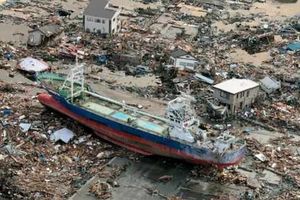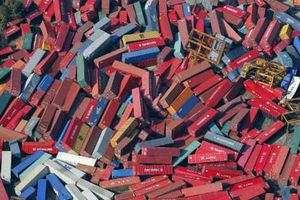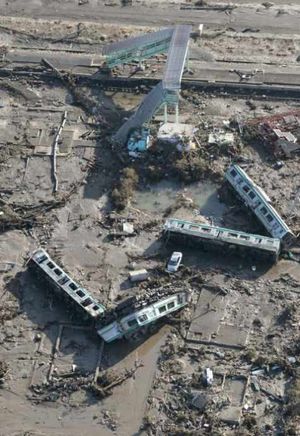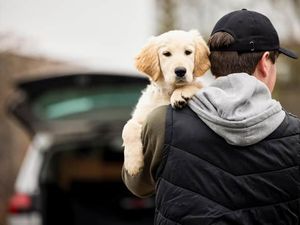Japan launches rescue operations after tsunami crisis
Japan today launched its biggest ever military rescue operation following the earthquake and tsunami which caused devastation across the country.

Japan today launched its biggest ever military rescue operation following the earthquake and tsunami which caused devastation across the country.
About 50,000 Japanese troops were being deployed to join rescue and recovery efforts following yesterday's 8.9 magnitude earthquake which was followed by a tsunami which washed far inland over fields, smashing towns, airports and highways in its way.
About 300 planes and 40 ships have also been reportedly mobilised by the Japanese government following the catastrophic disaster.
As the death toll was rising and hundreds of people were feared missing, rescue workers were bracing themselves for the worst as they had yet to reach the hardest-hit areas.
And the world was on standby to provide relief efforts to the country following the quake and 23ft high tsunami which swept away cars, planes and even buildings.
Officials were today checking whether a meltdown had taken place at the Fukushima Daiichi power plant, which had lost cooling ability in the aftermath of the quake.
Today, there were further fears of safety at the power plant site after it was rocked by an explosion.
Before the explosion Ryohei Shiomi, an official with Japan's nuclear safety commission, had said that because of the overheating at the plant a meltdown was possible at one of the reactors.
But even if there was a meltdown, it would not affect people outside a six-mile radius, he said. Most of the 51,000 residents living within the danger area had been evacuated, he said.
Today there was shaking and a trail of white smoke at the plant following an explosion, but the cause was still under investigation.
More than 215,000 people were living in 1,350 temporary shelters in five prefectures, or states, the national police agency said. Since the quake, more than one million households have not had water, mostly concentrated in north east.
The region continued to be jolted by tremors, even 24 hours later.
More than 125 aftershocks have occurred, many of them above magnitude 6.0, which even alone would be considered strong.
Technologically advanced Japan is well prepared for quakes and its buildings can withstand strong jolts, even a quake like Friday's, which was the strongest the country has experienced since official records started in the late 1800s. What was beyond human control was the killer tsunami that followed.
It swept inland about six miles in some areas, swallowing boats, homes, cars, trees and even small airplanes.
"The tsunami was unbelievably fast," said Koichi Takairin, a 34-year-old lorry driver who was inside his sturdy four-tonne rig when the wave hit the port town of Sendai.
"Smaller cars were being swept around me," he said. "All I could do was sit in my lorry."
His rig ruined, he joined the steady flow of survivors who walked along the road away from the sea and back into the city. Smoke from at least one large fire could be seen in the distance.
Smashed cars and small airplanes were jumbled up against buildings near the local airport, several miles from the shore.
Felled trees and wooden debris lay everywhere as rescue workers coasted on boats through murky waters around flooded structures, nosing their way through a sea of debris.
Basic commodities were at a premium. Hundreds lined up outside supermarkets, and petrol stations were swamped with cars. The situation was similar in scores of other towns and cities along the 1,300-mile-long eastern coastline hit by the tsunami.
Also today, operators at the Fukushima Daiichi plant's Unit One had to lower heat and pressure inside one of the reactors after the quake cut off electricity to the site and disabled emergency generators, knocking out the main cooling system.
Authorities detected eight times the normal radiation levels outside the facility and 1,000 times normal inside Unit One's control room.
The Tokyo Electric Power Co, which operates the six-reactor Daiichi site in north eastern Japan, said it had also lost cooling ability at a second reactor there and three units at its nearby Fukushima Daini site.
The government declared a state of emergency at all those units.
Japan's nuclear safety agency said the situation was most dire at Fukushima Daiichi's Unit One, where pressure had risen to twice what is considered the normal level. The International Atomic Energy Agency said in a statement that diesel generators that normally would have kept cooling systems running at Fukushima Daiichi had been disabled by tsunami flooding.
Japan gets about 30 per cent of its electricity from nuclear power plants.
Authorities warned citizens to be prepared for severe power cuts. More than one million households across Japan, mostly in the north east, still did not have access to water.
In the city closest to the epicentre of the earthquake, Sendai, as in many areas of the north east, cell phone service was down, making it difficult for people to communicate with loved ones.
"I'm waiting for my son to come here. But I cannot tell him he should come over here because mobile phones aren't working," a woman in her 70s said at a shelter in the town of Rikuzentakada, which appeared to be largely destroyed by the tsunami.
"My husband is missing," she said. "Tsunami water was rising to my knees, and I told him I would go first. He is not here yet."
Most trains in Tokyo started running again today after the city had been brought to a near standstill. Tens of thousands of people had been stranded with the network down, jamming the streets with cars, buses and trucks.
The city set up 33 shelters in city hall, on university campuses and in government offices, but many spent last night at 24-hour cafes, hotels and offices.
President Barack Obama pledged US assistance following what he called a potentially "catastrophic" disaster. He said one US aircraft carrier was already in Japan and a second was on its way. A US ship was also heading to the Marianas Islands to assist as needed, he said.
In Britain, The Foreign and Commonwealth Office advised against all non-essential travel to Tokyo and the north east of Japan, whilst it assesses the damage caused.
UK teams of experienced disaster response personnel are also on standby after making offers of assistance to the Japanese Government. US military vessels and aircraft carriers have already been sent to the disaster-stricken archipelago along with relief teams from Australia, New Zealand and South Korea.
The quake was around 8,000 times more powerful than the one that devastated Christchurch in New Zealand last month, and the fifth largest recorded since 1900.
It hit at 2.46pm (5.46am GMT) local time yesterday, unleashing a massive tsunami.
It was followed by more than 50 aftershocks, with a further earthquake measuring 6.6 hitting the mountainous central part of the country. Among Britons trying to reach loved ones, which proved difficult due to phone lines going down, were relatives of graduates on the Japan Exchange and Teaching programme.
A co-ordinator at the London office said between 300 and 400 Britons were in Japan.
She said: "We are still trying to get hold of them. Their parents are desperately trying to find out where they are."
Concerned relatives were urged to phone the crisis line in London on 020 7008 0000.
Asked about the possibility of British casualties, a spokesman for the Japanese embassy in London said: "So far as we are aware we haven't heard of any at this stage. We hope there aren't any of course but we can't say for sure."
Britons living in Tokyo said the quake was terrifying. Ellie Moe, 30, a mother of two originally from Hertford, was at home with daughters Shanna, three, and Ayala, 18 months.
Mrs Moe, whose husband Steven returned from seeing his parents in quake-hit Christchurch only on Monday, said: "Everything was shaking and banging, doors were opening and closing and I could hear lots of things falling over, but thankfully no furniture fell down.
"Afterwards we sat there glued to the ground, praying for my husband who works in the city in an older building with 5,000 people. Then the second one came, it seemed right away.
"My elder daughter Shanna was pretty scared but deals with situations like this by going to sleep and the baby, Ayala, I think thought it was a ride."
By John Kirk












